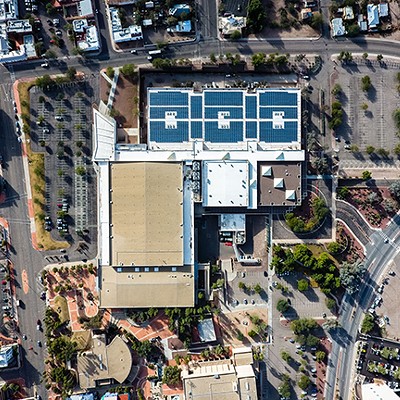"We see this stretch of arroyo--what we refer to as the last wild mile of Anklam Wash--as a vital link to what makes up the early version of our Tucson community," says ringleader and head CROW Carl Stoeckel.
As neighborhood residents went out for a jog or to walk their dog, they began to notice the stretch of wash from Silverbell Road and Speedway Boulevard to the Tucson Mountains was deteriorating.
"Banks were eroding and crumbling, and the wash was filled with trash, everything from bald tires and burnt-out appliances to construction debris. For all intents and purposes, the area was being used as a junkyard, a dumping ground that was obviously not on the radar screen of any official entities," says Stoeckel.
Rather than turn a blind eye and ignore the blight, or throw up their hands in despair at a worsening situation, residents decided to become activists and fix the problem in their own backyard. Two years ago, they noticed residents of nearby Ironwood Hills had applied for a grant which allowed them to plant trees and shrubs to upgrade that neighborhood. CROW members also took note of the fact that the city of Tucson had dug all the planting holes and put in irrigation for the fledgling trees.
"Once we had a model of how community improvements could be made through PRO neighborhood grants (People, Resources, Organizations in Support of Neighborhoods), we began to solicit support from area residents and businesses as a first step," says Stoeckel.
Done in businesslike fashion, CROW prepared a mission statement for their restoration plans along the Silverbell Corridor, "to create a cleaner, more natural state than currently exists." Promising a three-phase program (cleanup of accumulated trash within the wash, a pilot erosion-control project along side drainages and revegetation through reintroduction of a variety of native plants), the group last November received a $12,000 PRO grant: $3,500 in cash, with the remainder being in-kind services like equipment and supplies.
As fast as volunteer labor could pick up and bag trash, it was removed to a landfill--some 2,000 cubic feet of trash was taken away.
"The city of Tucson stepped in again with a front-end loader and driver as part of the construction crew to move the bigger boulders, the 200-400 pound rocks. Group volunteers have stayed busy stacking the smaller rocks in building between 150-175 trincheras (variously translated as trench, ditch, stockade, or fence) designed to slow down monsoon water flow and minimize further erosion," Stoeckel says.
More structures may be built before the grant runs out in mid-November--that is, if the rock pile and the volunteers who contribute sweat-of-the-brow labor hold up through the summer heat. As many as 40 area residents have been involved, and the pick-and-shovel crews span several generations, from children in the single-digit age bracket to people in their late 70s and early 80s, including some who have lived in the area their entire lives.
The success of their dam-building efforts awaits nature's test when monsoon runoff begins to trickle into and flow through the restored areas. "When the rains do come," says Stoeckel, "we'll work in partnership with Desert Survivors Nursery to scatter Bosque del Bac, a locally made habitat restoration mix of 21 different types of seeds. The variegated ground cover includes seeds of annuals, grasses, cactuses and trees aimed at slowing existing erosion and preventing further collapses in the future.
"Initially we felt that if we didn't take any positive, constructive action, this part of the wash would crumble and be gone, resulting in possible negative impact to 35 acres of adjacent open green space," Stoeckel adds. Another concern was the fact that the target site holds a piece of historic Tucson ephemera, footings from a smelter that operated on the southern bank of Anklam Wash from the 1880s through early 1900.
The CROW group is pleased that by stepping up and assuming leadership on the project, they have caused others to step forward to offer their services.
"It took our group activity to ring some alarms at the official level, sort of a "tsk, tsk" factor that woke up city concern and resulted in official involvement in the project. Through our actions and consequent increased public awareness, our CROW members have made our neighborhood, and our city, a better place to live. Our neighborhood efforts have allowed a means of ensuring the sustainability and viability of this specific portion of our fragile desert as the city of Tucson continues its growth," Stoeckel says.












